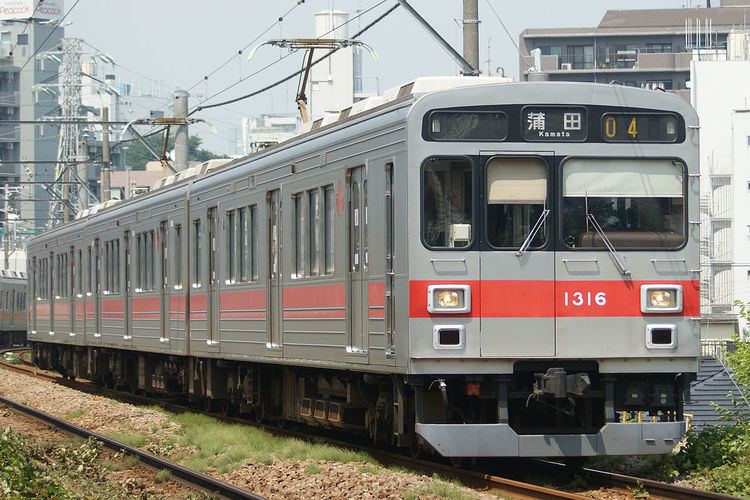In service December 1988 – Refurbishment 2014– Number in service 27 vehicles (9 sets) | Constructed 1988–1993 Number built 113 vehicles Formation 3 cars per trainset | |
 | ||
The Tokyu 1000 series (東急1000系, Tōkyū 1000-kei) is an electric multiple unit (EMU) train type operated by the private railway operator Tokyu Corporation on the Ikegami and Tamagawa lines in Japan since 1988.
Contents
Design
Based on the earlier Tokyu 9000 series design, the 1000 series trains were built for use on through-running services to and from the Tokyo Metro Hibiya Line subway. Cars are 18 metres long and have three pairs of doors per side.
Operations
3-car sets have operated on the Tokyu Ikegami Line since 1993. 4-car sets were formerly operated on the Tokyu Mekama Line (present-day Tokyu Tamagawa Line and Tokyu Meguro Line), and 8-car formations formerly operated on the Tokyu Toyoko Line, with through-running to and from the Tokyo Metro Hibiya Line subway. The former were reformed as three-car sets, and the latter were taken out of use from 15 March 2013. From May 2014, former 8-car Tokyu Toyoko Line sets were reformed into 3-car sets and refurbished for use on the Tokyu Tamagawa Line and Tokyu Meguro Line, reclassified as 1000-1500 series.
3-car sets
As of 1 April 2013, the fleet consists of nine 3-car sets, formed as follows, with two motored ("M") cars and one non-powered trailer ("T") car, and car 1 at the Gotanda/Tamagawa end.
Sets 1012 and 1014 have end cars with a central gangway door instead of the offset emergency gangway door on other units. These two sets were originally built as four-car sets designed to operate in pairs on Toyoko Line through services. Cars 2 and 3 are each fitted with a single-arm pantograph.
3-car 1000-1500 series sets
The 3-car 1000-1500 series sets are formed as shown below, with two motored ("M") cars and one non-powered trailer ("T") car.
8-car sets
The eight-car sets used on the Toyoko Line up until March 2013 were formed as follows, with car 1 at the northern end.
Cars 3, 5, and 7 were each fitted with a lozenge-type pantograph. Cars 2 and 7 included wheelchair spaces.
Interior
Passenger accommodation consists of longitudinal seating throughout, with a mixture of brown and orange seat moquette. The 1000-1500 series sets formed from 2014 have light green seat moquette and a wheelchair space added in the 160x cars.
History
Initially introduced on the Tokyu Toyoko Line from 26 December 1988, they were also introduced on the Mekama Line from 1991. These were transferred to the Ikegami Line from 1992, and further new trains were built for the Ikegami Line in 1993. The last set delivered, 1024, was the first Tokyu EMU to be built with a wheelchair space. The Ikegami Line fleet underwent modifications in 1998 for use on wanman driver only operation services.
Livery variations
From March 2016, three-car set 1017 received a dark blue and yellow retro-style livery based on the livery applied to the 3450 series trains that operated on the Ikegami Line until 1989.
Withdrawal and resale
Withdrawals started in 2008, with some cars being resold to the Ueda Electric Railway and the Iga Railway. Further cars were resold to the Ichibata Electric Railway in 2014.
Ueda Electric Railway
Eight former 1000 series end cars were resold to the Ueda Electric Railway in Nagano Prefecture, and reformed as four two-car 1000 series sets.
In 2015, two former 1000 series intermediate cars (1255 and 1305) were resold to the Ueda Electric Railway, which were reformed as a two-car 6000 series set with the addition of new cab ends.
Iga Railway
The two end cars from the former eight-car set reformed from two four-car sets 1010 and 1011 were resold to the Iga Railway in Mie Prefecture in 2009 after the set was withdrawn. The six intermediate cars of the set were scrapped. The two intermediate driving cars (with central gangway doors) originally formed in sets 1010 and 1011 before they were combined to become a single eight-car set were also sold to Iga Railway in 2010. Following its withdrawal in June 2009, eight-car set 1006 donated six cars, which were resold to Iga Railway between 2010 and 2012. The other two cars of the set were scrapped.
Ichibata Electric Railway
In 2014, four former 1000 series intermediate cars (1453, 1403, 1455, and 1405) were resold to the Ichibata Electric Railway in Ehime Prefecture, which were reformed as two-car 1000 series sets with the addition of new cab ends. These entered service on 9 February 2015.
